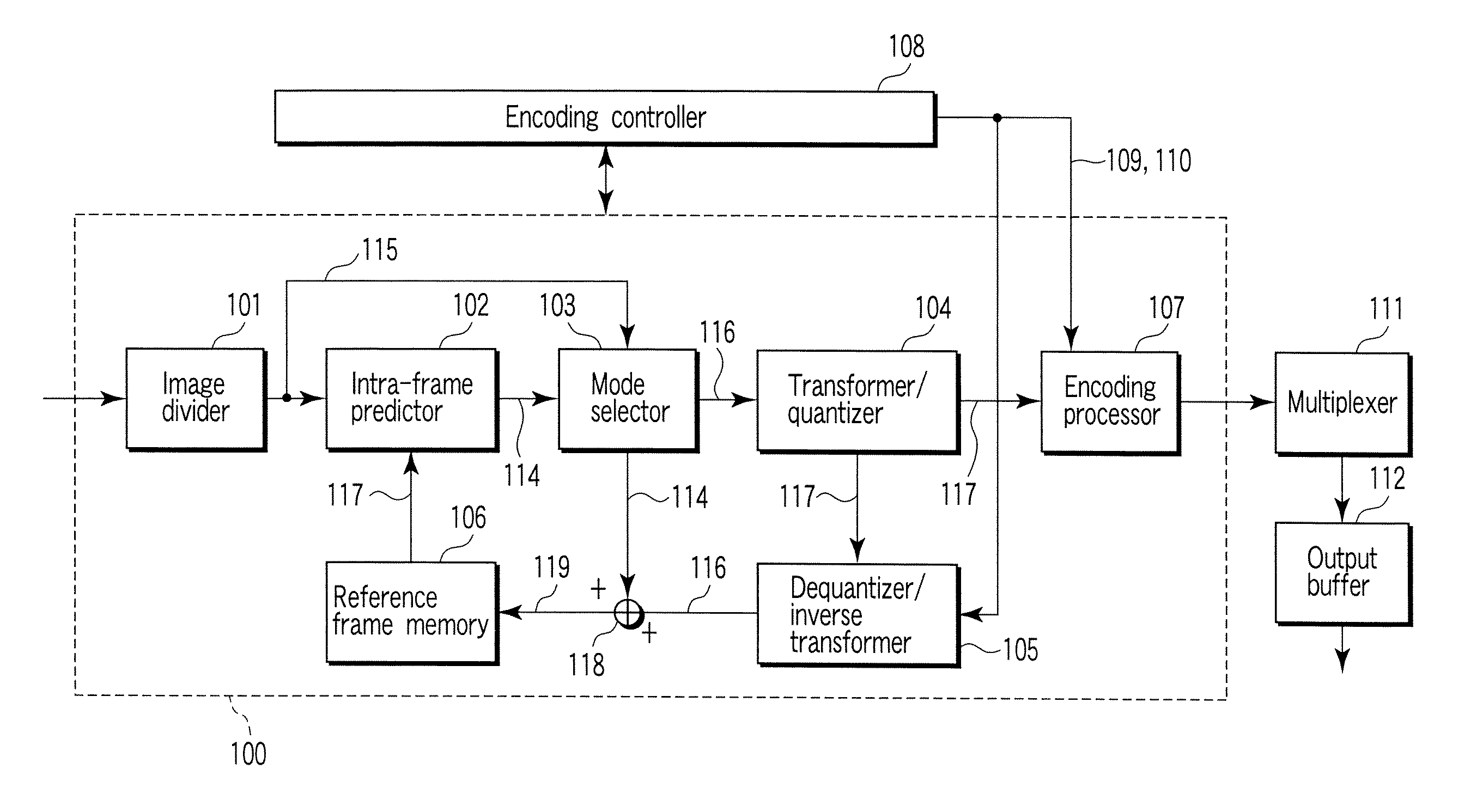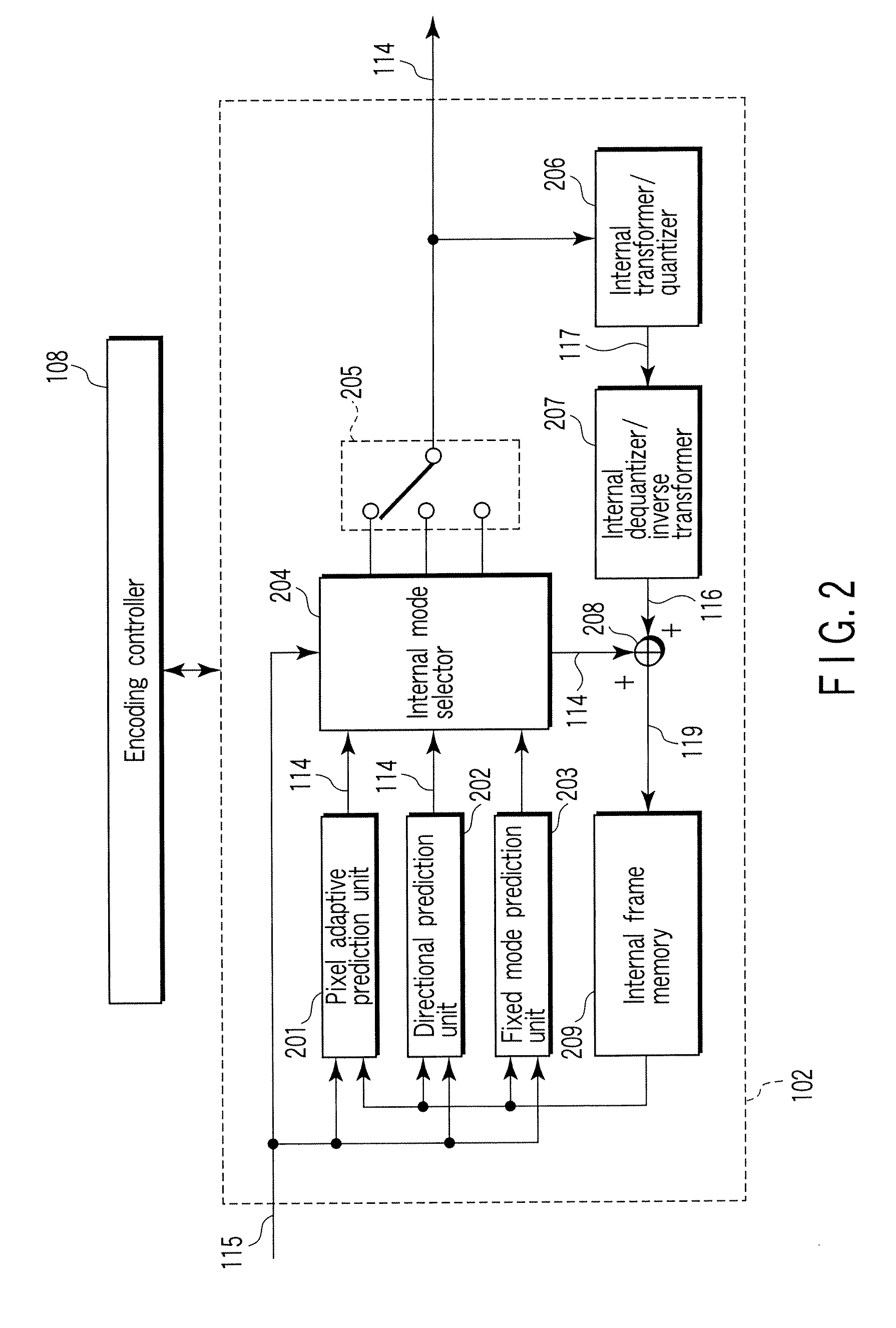Image encoding/image decoding method and image encoding/image decoding apparatus
a technology of image encoding and image decoding, applied in the direction of signal generator with optical-mechanical scanning, color television with bandwidth reduction, signal system, etc., can solve the problems of increased prediction error, prediction does not prove more accurate, prediction precision cannot be expected for an image,
- Summary
- Abstract
- Description
- Claims
- Application Information
AI Technical Summary
Benefits of technology
Problems solved by technology
Method used
Image
Examples
first embodiment
[0046] The video encoding apparatus 100 shown in FIG. 1 is configured to divide a video signal into a plurality of pixel blocks, and encode them. This video encoding apparatus 100 prepares a plurality of frame prediction modes which differ in block size and generation method of a predictive image signal from one another. Intra prediction is a prediction system which prediction is closed in a frame, and predicts a to-be-predicted block using an already encoded reference pixel. It is assumed that an encoding process is executed from an upper left to a lower right as shown in FIG. 4A in this embodiment.
[0047] The video signal input to the video encoding apparatus 100 is divided into a plurality of pixel blocks as an input image signal 115 with an image divider 101. A part of divided input image signal 115 is input to an intra predictor 102, and finally encoded with an encoding processor 107 via a mode selection unit 103 and a transformer / quantizer 107 to output coded data 113.
[0048] ...
second embodiment (
Encoding)
[0146] In a video encoding apparatus 1000 according to the second embodiment shown in FIG. 10, a temporary encoding / number-of-encoded bits counter 1001, an encoding distortion measuring unit 1002, an encoding change-over switch 1003 are added to the video encoding apparatus of the first embodiment. Since the intra predictor and the mode selector differ in function from the first embodiment, reference numerals different from those of the first embodiment are assigned to them.
[0147] In the present embodiment, like reference numerals are used to designate like structural elements corresponding to those like in FIG. 1 and any further explanation is omitted for brevity's sake.
[0148] The video signal input to the video encoding apparatus 1000 is divided into a plurality of pixel blocks with the frame divider 101. Each block is input to the intra predictor 1004 as an input image signal 115. The intra predictor 1004 generates a predictive image signal 114 with all prediction mode...
third embodiment (
Encoding)
[0177] In the third embodiment shown in FIG. 22, a first intra predictor 2202 and a second intra predictor 2203 are added to the second embodiment. Since the frame divider 2201 differ in function from the second embodiment, reference numerals different from those of the second embodiment are assigned to them. In the embodiment of FIG. 10, like reference numerals are used to designate like structural elements corresponding to those like in the embodiment of FIG. 1 and any further explanation is omitted for brevity's sake.
[0178] In the video encoding apparatus 2200 shown in FIG. 22, the first intra predictor 2202 differs from the first intra predictor 2203 only in a prediction block size, and the prediction method is same as the intra predictor 1004 shown in FIG. 11. An image divider 2201 divides an input video signal into a plurality of pixel blocks. At this time, the macroblock is divided in different block shapes. One macroblock is divided into 16 4×4-pixel blocks, and th...
PUM
 Login to View More
Login to View More Abstract
Description
Claims
Application Information
 Login to View More
Login to View More - R&D
- Intellectual Property
- Life Sciences
- Materials
- Tech Scout
- Unparalleled Data Quality
- Higher Quality Content
- 60% Fewer Hallucinations
Browse by: Latest US Patents, China's latest patents, Technical Efficacy Thesaurus, Application Domain, Technology Topic, Popular Technical Reports.
© 2025 PatSnap. All rights reserved.Legal|Privacy policy|Modern Slavery Act Transparency Statement|Sitemap|About US| Contact US: help@patsnap.com



